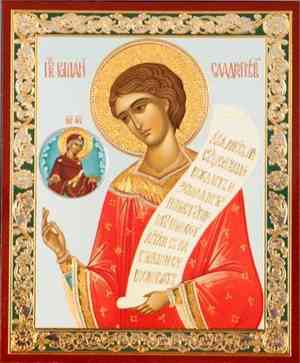


Romanos the Melodist
Depicted with the Theotokos (Mother of God)
Source:
St. Peter & St. Paul
Romanos the Melodist is as far back as this history traces, not ancient, though of late antiquity at the Early Middle Ages also known as the Dark Ages when power in Rome was lost to emperors toward assumption by the Catholic Church. Classical music would be tied to the Catholic Church for another millennium until sharing its fostership with the Protestant Church, all of which is preparatory to Classical music proper as exemplified in Mozart. The last emperor of the Western Roman empire, Julian Napos, had been assassinated in 480. Emperor of the Eastern Roman Empire, Zeno, ran the Mediterranean from Constantinople. Attila the Hun had only recently ceased to be a threat to both empires upon his death in 453. Despite pressing barbarians (any not Roman or Chrisyian), Christianity had been slowly growing in the West the way a tree takes root in the crack of a rock. By 500 AD the Catholic Church had been through fifty popes if count Peter,and the seat was in contest between Symmachus and Laurentius. St. Brigid had founded Kildare Abbey in 490, a monastery in Ireland destroyed seven centuries later. Clovis had managed to convert Franks to Catholicism in 496. Zeno was head of the Eastern Orthodox Church from which Alexandrians in Egypt split to create the Coptic Orthodox Church in 497. Christian hermitage had been in full swing for a few centuries now, ironically famous during this period being the Grecian Eastern Orthodox Cyriacus the Anchorite who died at the Cave of St. Chariton in Palestine above one hundred years old in 557, also venerated by the Coptic Church.
Oriental Asia in the Far East was as
distant as the Big Bang so far as Western civilization yet reforming was
concerned. It was about 500 AD that the Frankish Kingdom was wrought, while
across the Channel the
Kingdom of Essex was founded by the invading
Anglo-Saxons (Germanic). The legendary British King Arthur is supposed to
have been active in 500 AD, perhaps leading the Battle of Mons Badonicus
against Anglo-Saxons in 497. The Anglo-Saxon claim to England would be
contested continuously for centuries to come. Farther northeast, it was
about 500 AD that Goths (Germanic), who had sacked Rome in 410 AD, founded
the first Swedish state called Svealand.
Such was western civilization's setting in the rough into which period Romanos the Melodist was born circa 490 in Syria, a Greek Byzantine hymnographer who composed for both the Eastern and Western Catholic Church, though he largely wrote kontakia (hymns) for the Eastern Church. Thought to have been a Jew born in Emesa (now Homs) or Damascus, Romanos became a deacon in the Church of the Resurrection upon traveling to Beirut. He soon moved onward to Constantinople where he is thought to have lived during the reigns of Anastasius I, Anastasius II and Justinian, serving as a sacristan (church keeper) in the Hagia Sophia (Great Church).
'Kontakion of the Nativity' is Romanos' best-known work, dated to 518, followed by a second of unidentified date. His kontakia would have been sung in the Constantinoplian Greek of his period. He is generally, if not certainly, credited with writing the Akathist Hymn in thanksgiving to the Mother of God on an unidentified date around 530.
'Kontakion of the Nativity No.1' sung by Khouria Frederica
Romanos died approximately 556 in Constantinople, and was sainted a patron for singers by the Eastern Orthodox Church.
Sources & References:
Antiochian Orthodox Christian Archdiocese of North America
GEDSH
Viola Fair (further reading)
Akathist Hymn in thanksgiving to the Mother of God:
Greek Orthodox Archdiocese of America
Orthodox Christianity (Job-Carney-Ephrem)
Anglo-Saxon Britain:
Cyriacus the Anchorite:
The Hagia Sophia:
Historical Timelines:
Wikipedia (popes)
The Kontakion (hymn form of the Eastern Orthodox Church):
St. Nicholas Russian Orthodox Church
Kontakion of the Nativity (first):
Score by Frederick Karam
Kontakion of the Nativity (second):
Father John (St. John of Chicago Orthodox Church)
Discographies:
Classical Main Menu Modern Recording
hmrproject (at) aol (dot) com